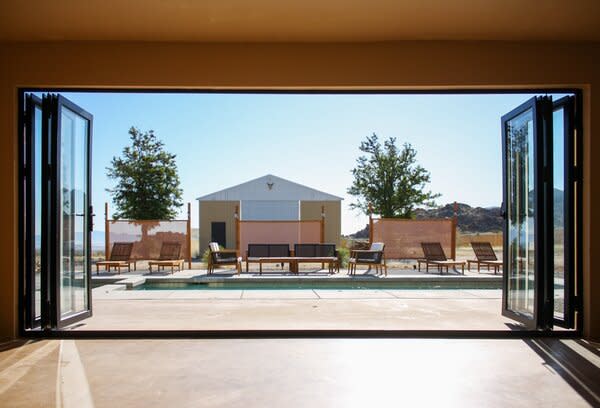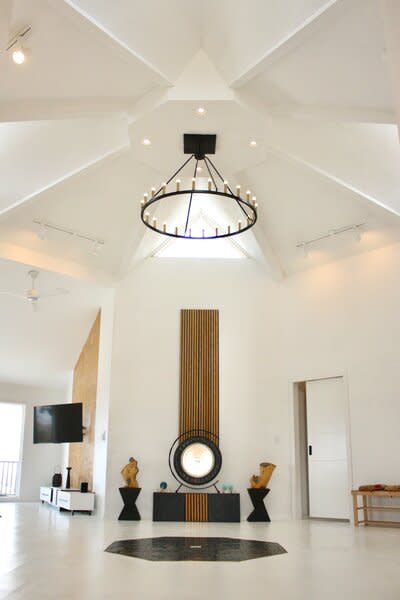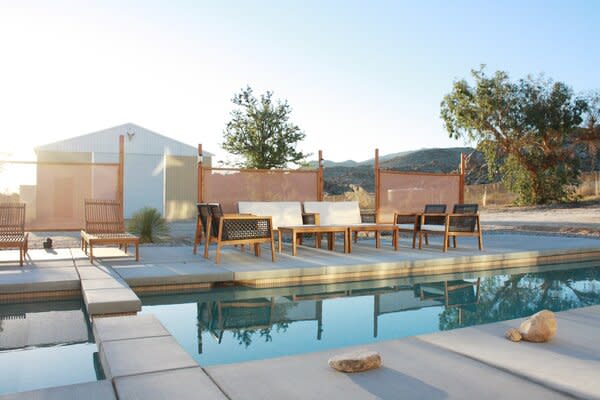How I Turned an Octagonal Joshua Tree House Into a Sustainable Oasis
I gave up my apartment and much of my old life in exchange for a valuable lesson—learned via sweat equity—about where our resources come from.

In 2022, I purchased a 5-acre property with a rare octagon house on it near Joshua Tree National Park, with the intention to both live there and remodel it into a sustainable wellness ranch, complete with mineral springs baths for relaxing and recharging under the stars. At the time, however, my understanding of sustainability was limited; I was a city girl from Los Angeles, a former MTV VJ, and investigative journalist with no experience in homebuilding or even composting. But my heart was set on purchasing my first home and inspired by a vision of an earth-conscious East meets Wild West oasis, I set out on my plan fortified by DIY videos and an immigrant’s will.
Over the course of the year I spent remodeling the property in the middle of the Mojave, I learned a critical thing: sustainability itself needs to be sustainable not only for the Earth, but for the people practicing it. In order to last for generations, it requires pragmatism rather than strict asceticism (or at the other end, exploitation). A feeling of mutual abundance, not deprivation. There are numerous attainable ways to do this.
Know the land and be on the lookout for potential
When I came across my octagon house listing, I knew it was what I was looking for even though it didn’t meet a few requirements, like proximity to a fault line to harness natural hot water. Yet it was nestled in the nook of a small mountain with massive tan boulders, dotted with star-like yucca near the border of Joshua Tree National Park in Twentynine Palms—only five minutes from the Fortynine Palms Oasis, a rare natural oasis along the park’s only free hiking trail.
Joshua Tree is in the Mojave rain shadow, an area with significantly less rainfall due to its location behind the Sierra Nevada mountains in California—essentially a desert within a desert. This made the concept of a hydrotherapeutic property especially difficult. But there were other advantageous natural features, like geothermal energy and a nearby extinct volcano which left the area especially dense with unique fault lines, linked with groundwater at the Earth’s surface.
Other hot spring destinations in the area were extremely close to fault lines. In the nearby valley of Desert Hot Springs, the celebrity-favorite wellness resort Two Bunch Palms is located directly over the San Andreas fault. More mineral springs flow in that area than anywhere else in the country. In the elevated plateau of Joshua Tree, where a proliferation of short-term rentals have popped up over the last few years, there still wasn’t such a destination in the central Yucca Valley-Twentynine Palms region.
The area had become gentrified with newcomers like me, part of the mass urban-to-rural migration of working professionals spurred by the Covid pandemic, but began even before due to high costs of living, quality of life, and other reasons. Renovating old properties for the Airbnb market was a common income source for many, including myself, who couldn’t afford to create a mineral springs home otherwise. And after years of working at the frenzied frontlines of news and media, I needed to create a wellness destination not only for financial purposes, but for my own healing process. Baths have always been an essential part of my self-care routine, and I dreamed of having a space to share this precious practice with others.
So while my 5-acre property wasn’t near a fault line, it was nearly walking distance to the Fortynine Palms Oasis, which meant its groundwater likely came from the same lush aquifer. The land already had an old well along with city water, a local luxury. It also had a 1,200 square-foot barn, perfect for a future pickleball court protected from desert winds, and the two-story octagon house, which despite the popcorn ceilings and cat urine-drenched carpet, had clear potential to become a spa-like Shangri-la. The octagon foyer with towering ceiling and skylights was the Eastern influence I’d been seeking, as the eight-sided shape symbolizes rejuvenation in Buddhism. The East is the origin of powerful and popular forms of self-care—from yoga to meditation—and blending that reference with homage to my Korean background was important to me.
Cut costs where you can
The house was twice my budget. But my previous offers had all been outbid by cash buyers, and I realized I’d constantly be outbid unless I looked in a higher bracket—there are more buyers willing to pay $200,000 cash than $400,000. With interest rates about to balloon, I also couldn’t afford to wait too long to get lucky. So I decided to take my chances and seize the opportunity. I paid $430,000 for the property, which meant making some sacrifices. I let go of my rental in Venice Beach and fully left L.A., which meant I also lost work opportunities and lived off savings. I had to hedge my bet on the hope that the finished property would recuperate income as a short-term rental as soon as it was done.
I also put in more sweat equity by doing most of the remodeling labor, a stressful endeavor amplified by the tight timeline to finish before the savings ran out. With another loan, I upgraded the property to an off-grid solar system, adding around $45,000 to my debts.
These challenges informed the second part of my green approach—sustainability is a spectrum within the confines of one’s resources. It’s okay to go one step at a time.
Do (a lot of) it yourself
Not everyone can afford to exclusively use reclaimed teak or plant-based paint at $70 a gallon—and you’ll probably need to buy twice the number of gallons as regular paint because the biodegradable stuff spreads thinner. Remodeling is expensive, and it’s even more expensive trying to save the world doing it.
Instead of throwing away the old doors and trim gouged with cat scratches, I filled in the markings with wood filler, sanded them smooth, and repainted them a polished copper. I removed the reeking carpets along with the drab vinyl tiles, exposing a lovely rust-colored concrete floor that I left exactly as is. In the kitchen, I replaced the old range burner with a modern electric Samsung stove, operated with maximal energy efficiency at no cost thanks to the solar panels. For the old well to be up to code, its cement foundation had to be expanded by a couple of square feet, quoted at almost $1,000. Instead I bought bags of Quikcrete from Home Depot for less than $50, made some forms with scrap boards, and poured the slab on my own at 1/20th of the cost.
See the full story on Dwell.com: How I Turned an Octagonal Joshua Tree House Into a Sustainable Oasis




